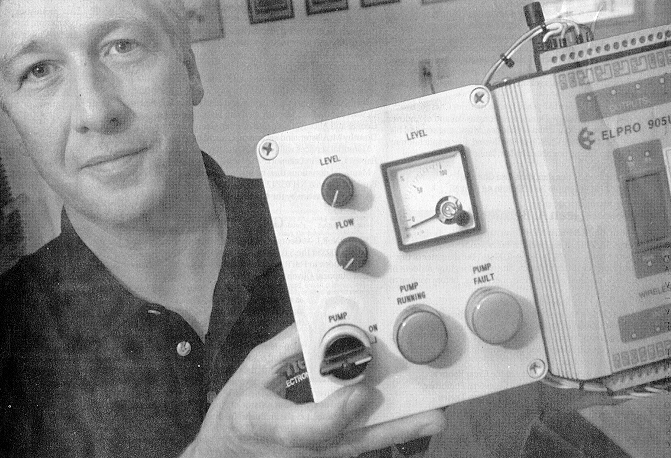by Colleen Lent
The Hampton Union, Tuesday, September 23, 2003
[The following article is courtesy of the Hampton Union and Seacoast Online.]

in 1982, is located at 24 Stickney Terrace in Hampton. Their website is at www.processinstrumentation.com.
In 1982, the year Process Instrumentation Inc. in Hampton was established, Ronald Reagan’s supply-side economics was the touted prescription for an ailing economy. In 2003, “downsizing” is the boardroom aspirin for companies grappling with financial headaches while trying to remain competitive.
Paul Richards, PII’s president, says his company has adapted its product and service line over the past 21 years to meet the changing needs of its New England customers.
Richards doesn’t claim that his company is a life jacket for industrial customers drowning in a sea of red ink. However, the company has figuratively evolved from being a single-blade pocketknife to a multi-purpose Swiss Army knife.
In its infant years, PII acted as a manufacturers’ representative, distributing instrumentation products such as power monitors and gas sensors. Richards tries to explain in simple terms what his company does.
“We provide equipment to manufacturing companies to help optimize the production process,” he says. “We supply the devices that can measure things like temperature.”
PII represents a wide gamut of manufacturers, ranging from ThermoBrandt to General Monitors to Beta Calibrators. When an industrial company can monitor and control what goes on its its facility, efficiency is increased, quality is improved and energy is saved, according to Richards.
In its adolescent years, PII expanded its customer offerings, adding service items, such as integration and technical support, to its menu. With companies forced to adopt a lean and mean operating philosophy, employing full-time maintenance staff or hiring multiple contractors is much like hitting the corporate piggy bank with a sledgehammer.
Richards says PII’s customers are looking for vendors who can offer one-stop shopping. In other words, PII doesn’t just sell a part, wipe the dirt from its hands and walk away, humming, “Well, our job is done.” While the company doesn’t install its products, it makes an assessment of the customer needs, recommends a solution, customizes product software and monitors progress through after-sales support.
“We’ll try to understand what their needs are,” Richards says. “Technical support helps people apply technology appropriately”
Simply stated, Richards says a business-savvy company needs to have a before, during and after-sales plan. Philip Kotler, author of “Marketing Management: Analysis, Planning, Implementation, and Control,” says organizations need to focus on customer retention in addition to new business generation. Richards says Kotler’s advice makes sense.
“Certainly it’s more profitable to maintain and expand business with an existing customer,” he says. Richards adds that PII employees spend considerable training hours to understand the products the company distributes, enabling them to answer customer questions and troubleshoot future problems.
“That plays into the retention part,” Richards says. Innovation is the second part of the retention and competition equation, according to Richards.
As an adult company, PII, is matching a $40,000 grant received from the New Hampshire Industrial Research Center (NHIRC) at the University of New Hampshire in Durham to develop a wireless instrumentation interface system. Richards says if the research project is successful, it will “marry” industrial sensors with wireless communications via radio waves.
Wireless systems provide a host of advantages over traditional hard wire systems, including lower installation costs and easier maintenance, according to Richards and the Office of Industrial Technology.
In turn, with reduced “deployment” costs, industrial companies will be better equipped to monitor and control energy savings. Richards says PII is anticipating the success of the wireless system, which is scheduled for testing at the UNH campus this fall. In response, a second company, Wireless Sensors, LLC, has been established as the manufacturing arm of PII.
Richards and his colleagues are well versed in the sales and marketing strategies, and don’t expect obstacles in setting up product distribution channels.
“That’s in one sense the easy part,” Richards says. On the other hand, donning the hat of a manufacturer is a new venture for the company. Richards says that by being located on the Seacoast, PII has plenty of resources available to assist with various phases of the manufacturing process. While he says it’s a little premature to start setting up an outsourcing network, PII is working with a Massachusetts firm to design circuit boards for the new technology. P11 is planning on assembling and conducting final testing in house.
“You want to make sure you have your arms around quality and performance before a product goes out the door with your name on it,” Richards says. As PII and the NHIRC are targeting General Electric, Dow and other Fortune 500 companies as future wireless instrumentation interface system customers, Richards says his company’s current geographic reach will extend beyond New England.
“That would entail ultimately worldwide distribution, initially North America,” he says. The cynic may say the wireless system won’t go global. Similarly, in 1943 Thomas Watson, chairman of IBM at the time, said there was a worldwide market for about five computers.